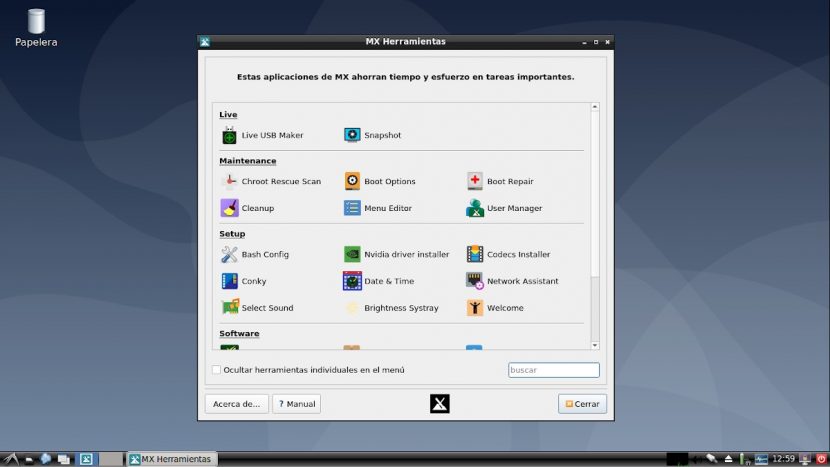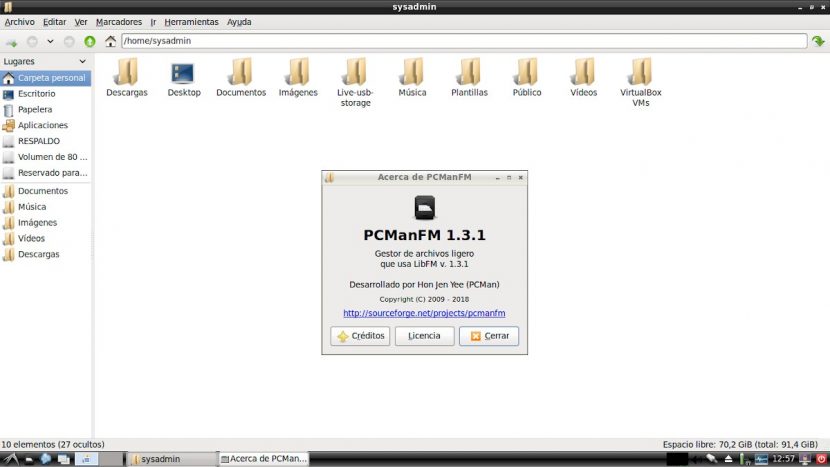
LXDE: What is it and how is it installed on DEBIAN 10 and MX-Linux 19?
LXDE it is a light and fast Desktop Environment, as much as XFCE y MATE. About LXDE not usually as much information abound as with others. For example, our last post specify about LXDE, it was more than 1 year ago, on how to make a backup copy of it.
This is surely due to the fact that there are usually few GNU / Linux distributions that include it like Default Desktop Environment. Therefore, in this publication we will focus especially on What is it? y How do you install?. Emphasizing, of course, the current DEBIAN GNU / Linux meta-distribution, in its most recent version, number 10, code name Buster. Which is also currently the basis for the Distro MX-Linux 19 (Ugly Duckling).

Citing official information, the following can be expressed:
"LXDE, what does it mean Lightweight X11 Desktop Environment, it is a fast and lightweight desktop environment. It is designed to be user friendly and lightweight while keeping resource usage low. LXDE uses less RAM and CPU, while being a feature-rich desktop. Unlike other heavily integrated desktops, LXDE strives to be modular, so that each component can be used independently with few dependencies. This makes porting LXDE to different distributions and platforms easier. ”. Official LXDE Wiki

All about LXDE
Description
Among the most important that can be highlighted from this Desktop Environment we can mention the following points:
- LXDE was released partially in the year 2006 by the Taiwanese computer scientist Hong Jen Yee When finished PCManFM, the first desktop module. Then the full desktop of LXDE, with the aim of serving the development of low energy and resource consuming distributions.
- Currently going for the version 0.8 (stable).
- LXDE is available through the official repositories in many GNU / Linux Distros, such as: DEBIAN, Ubuntu and Fedora. And some bring it by default when they are focused on low-resource consumption teams.
- El application ecosystem native to LXDE It is made up of several programs, the following being the most emblematic or well-known: PCManFM (File manager), leaf pad (Text editor), GPicView (Image Viewer), among many others.
- LXDE is made in GTK + 2. But it has a parallel development called LXQT, which we will talk about in another post.
Note: LXQT is Desktop Environment current carried out by Hong Jen Yee and its community of Developers, but have not abandoned the development of LXDEas they are trying to port it to GTK + 3 for compatibility with the Gnome3 Environment. Thus, how they carry LXQT with QT5 and KDE Frameworks 5 to achieve compatibility with the KDE Plasma environment.
Advantages and disadvantages
Advantages
- It is a Desktop Environment fast and low consumption. Its strength lies in being designed to be lightweight, use less CPU and RAM than others, and benefit its use in low-performance equipment.
- It is maintained by a international developer community currently working to maintain the stability and validity of the Environment while achieving its possible migration to GTK + 3.
- Comes with a eye-catching interface but with traditional features.
- It has positive aspects such as multi-language support, creation of standard hotkeys and additional functions such as tabbed file browsing.
- Today LXDE is supported by Linux. Although it has also been tested on FreeBSD. So it is basically supported by almost any system based on Unix.
- It does not depend on any desktop, that is, its components can be used independently of the Desktop Environment itself LXDE.
- Its design is adjusted to standards emanating from freedesktop.org.
Disadvantages
- It does not have its own window manager, but it is usually used mostly with open box.
- Its base is still in GTK2 but it has an experimental version of LXDE based on GTK + 3, created with support from user group of Arch (lxde-gtk3).
- It is in full development and has not reached your first mature version (1.0) but his community grows every day due to its main benefits that are very stable.
- Is recommended for users with a higher level of experience than normal, since everything is not so close at hand, and to squeeze its potential requires a good command of Linux.
For learn more you can visit its official website and that of its creator Distro:
Where you can access practical official sections, such as a Blog, Wiki and Forum, among many others. The following links are also available to supplement the information on LXDE:

Installation
In case one currently has a GNU / Linux DEBIAN 10 distribution (Buster) or others based on it, such as MX-Linux 19 (Ugly Duckling), the most recommended installation options are:
Using the Tasksel command via Graphical User Interface (GUI)
- Run a Console or Terminal from the Desktop Environment
- Run the command orders next:
apt update
apt install tasksel
tasksel install lxde-desktop --new-install- Continue until the end on Tasksel Guided Procedure (Task Selector).
Using the Tasksel command via the Command Line Interface (CLI)
- Run a Console or Terminal using the Ctrl + F1 keys and start a super user root session.
- Run the command orders next:
apt update
apt install tasksel
tasksel- Select the LXDE Desktop Environment and any other utility or set of additional packages.
- Continue until the end on guided procedure de Tasks (Task Selector).
Installing the minimum necessary packages directly via CLI
- Run a Console or Terminal from the Desktop Environment or using the Ctrl + F1 keys and start a super user session root.
- Run the command orders next:
apt update
apt install lxde- Continue until the end on procedure guided by Apt Package Installer.
Note: You can also install a Desktop Environment based on LXDE easier by replacing the package lxde by lxde-core.
Extra or complementary actions
- Execute actions of optimization and maintenance of the Operating System running the command orders following:
apt update; apt full-upgrade; apt install -f; dpkg --configure -a; apt-get autoremove; apt --fix-broken install; update-apt-xapian-indexlocalepurge; update-grub; update-grub2; aptitude clean; aptitude autoclean; apt-get autoremove; apt autoremove; apt purge; apt remove; apt --fix-broken install- Restart and login by selecting the Desktop Environment LXDE, in case of having more than one Desktop Environment installed and not having selected the Login Manager
ldxe-session.
For more additional information visit the official pages of DEBIAN y MX-Linux, or the DEBIAN Administrator's Manual online in its stable version.
And remember, this is the fifth post of a series about GNU / Linux Desktop Environments. The previous ones were about GNOME, KDE Plasma, XFCE, Cinnamon y MATE. While the last one will be about LXQT.

Conclusion
We hope this "useful little post" about him «Entorno de Escritorio» known by the name of «LXDE», which is considered one of the lightest and simplest, just like XFCE, with a traditional style and a small and incipient set of native applications, within the world of «Distribuciones GNU/Linux», is of great interest and utility, for the entire «Comunidad de Software Libre y Código Abierto» and of great contribution to the diffusion of the wonderful, gigantic and growing ecosystem of applications of «GNU/Linux».
And for more information, always do not hesitate to visit any Online library as OpenLibra y jedit to read books (PDFs) on this topic or others knowledge areas. For now, if you liked this «publicación», don't stop sharing it with others, in your Favorite websites, channels, groups, or communities of social networks, preferably free and open as Mastodon, or secure and private like Telegram.
Or simply visit our home page at DesdeLinux or join the official Channel Telegram from DesdeLinux to read and vote for this or other interesting publications on «Software Libre», «Código Abierto», «GNU/Linux» and other topics related to «Informática y la Computación», and the «Actualidad tecnológica».
I have Debian 10 with LXDE and XFCE installed, and it happens to me that the new version of the WPS Office 11.1.0.9080 office suite does not start in LXDE, but if in XFCE, the previous version did work in LXDE. Does anyone know about this problem and how to solve it?